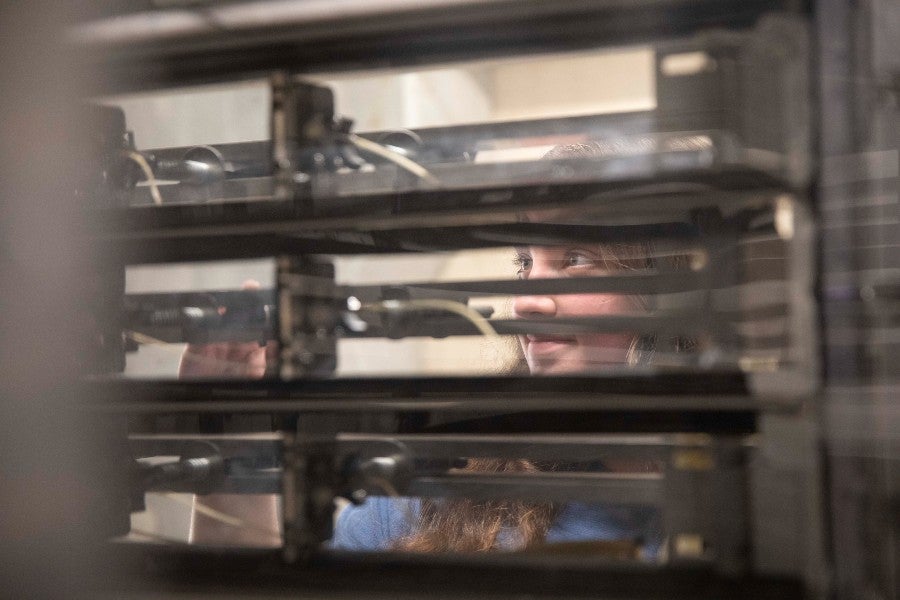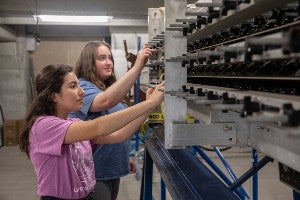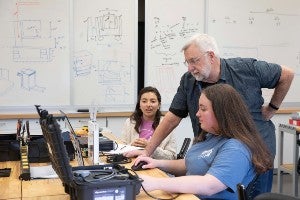Engineering college has the wind at its back
Private donation and grant expands learning and discovery opportunities through wind tunnel.
Janel Shoun-Smith | 615.966.7078 |

Not many students get the opportunity to actually build a better education for those who follow them. For Lipscomb’s engineering majors in the Raymond B. Jones College of Engineering, however, it just comes with the territory.

Summar Hill and Bibiana Zermeno-Magan
This summer, thanks to the 2019 donation of a wind tunnel and annual grants from the Tennessee Space Grant Consortium, two mechanical engineering majors, Summar Hill and Bibiana Zermeno-Magana, are working to make the wind tunnel more valuable for future students, and potentially local industries, by designing a system to install and use a sting balance within the wind tunnel.
The 2022 Tennessee Space Grant Fellows are just the two latest in a string of students who helped install the tunnel, hook up the electrical instrumentation and make the tunnel operational for future use, said Dr. Fort Gwinn, associate dean of engineering who is overseeing the two students this summer.

Dr. Fort Gwinn, Summar Hill and Bibiana Zermeno-Magana
The 40-foot wind tunnel, donated by international engineering firm Jacob Corporation, has already provided a wealth of hands-on, real-world learning opportunities.
In the fall of 2020, a team of seven electrical and computer engineering students spent the 2020-21 school year installing the wind tunnel, a 40-foot long device donated by international engineering firm Jacob. They developed the computer data acquisition system as well as ensuring its safe and effective operation. The senior project provided students practice in data acquisition and controls, measurement and instrumentation, image processing and facility automation.
During the 2021-22 school year, two Tennessee Space Grant fellows zeroed in on taking flow stream measurements so the college can characterize the airflow quality. “The top air speed was 170 mph and it was fairly uniform,” Gwinn reports.
The tunnel will be used for predictive testing: models of cars, planes or machinery parts can be tested to see how they change, bend or break based on their shape under the influence of airflow, said Dr. David Elrod, dean of the engineering college.
Through the use of the college’s Innovation Lab, which includes four 3D printers, Lipscomb students will have the capability to build models, print them in 3D printed materials, and immediately test them in the tunnel, said Elrod. Students participating in Lipscomb’s competitive engineering design teams, which are or have created rockets, aircrafts, concrete canoes, steel bridges and all-terrain vehicles, could all make use of the wind tunnel to test prototypes and refine their designs.
Working toward that goal, Hill and Zermeno-Magana are working this summer to install the sting balance, a device that measures the lift and drag on aerospace or automotive models placed in the tunnel. The sting balance was purchased through an additional grant from the Tennessee Space Grant Consortium, a group of 15 colleges and universities that are part of the National Space Grant College and Fellowship Program, supported by NASA and all member and affiliate institutions.
With their work this summer, and the work of a second senior design team this fall to develop the instrumentation for the sting balance, the wind tunnel should be fully operational by the end of 2022, ready to provide expanded student and faculty research opportunities by testing prototype models and conducting more advanced experiments, said Gwinn.
“The wind tunnel allows Lipscomb to serve a unique role in encouraging aerospace research in the Middle Tennessee area through our membership in the Tennessee Space Grant Consortium,” said Elrod, a former aerospace engineer who spent much of his career at Jacobs.
The tunnel will enhance potential research opportunities in product development for automotive secondary markets, studies for the racing industry and basic research in aerodynamics, he said.
In addition, the wind tunnel allows the college to enhance its STEM outreach to a diverse future generation of engineers, said Elrod. Already, in the summer of 2021, recent high school graduates in the Lipscomb academic bridge program AERO were able to get a glimpse of the engineering career field through a demonstration of the wind tunnel.
“We focus on developing highly skilled engineers through the use of project-based learning inside and outside of the lab,” Elrod said. “These projects are not the standard cookie-cutter lab with prescribed steps and predetermined outcomes. We believe that connecting theory to real-world design problems increases learning outcomes and helps with student retention.”
Powered by a 40 hp fan, the Jacobs wind tunnel was originally used for scale model testing of passenger cars and racecars and for wind tunnel technology development, said Steve Arnette, senior vice president at Jacobs.
The adaptive walls of the wind tunnel allow the device to change the size of the testing area and thus accurately simulate real-world aerodynamics in the laboratory. It can be used to study and test the aerodynamics of motorcycles, aircraft, flying drones and other aerospace vehicles, Arnette said.
Jacobs Engineering Group, an international technical, professional and construction services firm with operations in Tennessee, donated the tunnel, worth $750,000, in order to strengthen its relationships with local universities by providing opportunities for hands-on education and research, said Arnette.
“Lipscomb University submitted a very comprehensive proposal,” said Arnette, “explaining their plan and outlining ways to further enhance the two-way relationship between Lipscomb University and Jacobs Engineering, which spans two decades.”